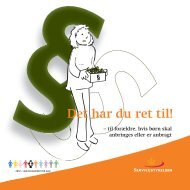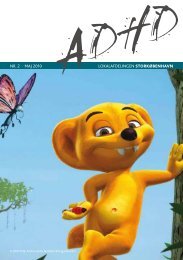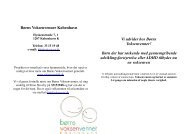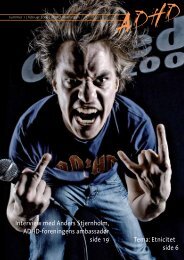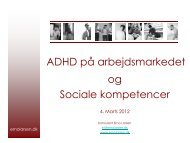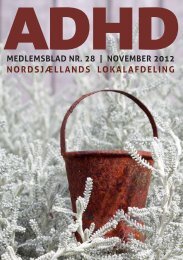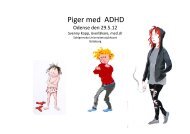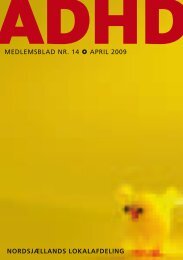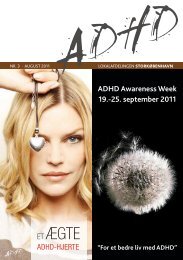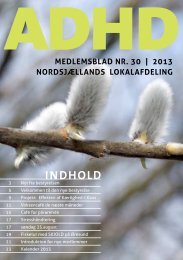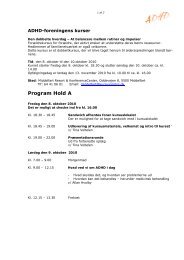Diagnostic Assessment & Treatment of Adult ADHD
Diagnostic Assessment & Treatment of Adult ADHD
Diagnostic Assessment & Treatment of Adult ADHD
- No tags were found...
You also want an ePaper? Increase the reach of your titles
YUMPU automatically turns print PDFs into web optimized ePapers that Google loves.
Topics• Neurobiology <strong>of</strong> <strong>ADHD</strong>• Prevalence in adults• Clinical picture• <strong>Diagnostic</strong> assessment• <strong>Treatment</strong>
<strong>ADHD</strong> IS NOT OUTGROWN
Neurobiology <strong>of</strong> <strong>ADHD</strong>• Highly heritable (80% <strong>of</strong> variance explained bygenetic factors)• Neurobiological disorder:– brain 5% smaller and less active: dACC, globuspallidus, caudatus, dLPFC, cerebellum– 8 kandidate genes, esp. dopaminergic (DRD2,4,5,DAT1)– Inhibition deficit based on dopamine deficiency– Methylphenidate: dopamine agonist; acts as inhibitor<strong>of</strong> associations, moodswings, restlessness andimpulsivityThapar 1999; Faraone 2005; Castellanos 2002; Bush 2006Kessler 2006; Kooij 2005
<strong>ADHD</strong> symptom scores in twin studies:highly heritableBoomsma 2003Martin 2002Kuntsi 2001Coolidge 2000Thapar 2000Willcutt 2000Hudziak 2000Nadder 1998Levy 1997Sherman 1997Silberg 1996Gjone 1996Thapar 1995Schmitz 1995Stevenson 1992Edelbrock 1992Gillis 1992Goodman 1989Matheny 1980Willerman 19730 0.2 0.4 0.6 0.8 1Heritability
Developmental trajectories<strong>of</strong> brainvolumes(Castellanos et al., JAMA,2002)
Anterior Cingulate (Cognitive Division)Fails to Activate in <strong>ADHD</strong>MGH-NMR Center & Harvard- MIT CITP Bush et al., Biol. Psychiatry, 1999Normal Controls<strong>ADHD</strong>y = +21 mm1 x 10 -2 y = +21 mm1 x 10 -2-31 x 10 1 x 10-3
The brain in <strong>ADHD</strong>compared to controls:Smaller,Less active&Impairedfunctioning
Clinical picture <strong>of</strong> <strong>ADHD</strong>Lifetime symptoms <strong>of</strong> Attention-Deficit/Hyperactivity Disorder:• Inattention: distracted, chaotic, forgetful, late, difficultymaking decisions, organising and planning, no sense <strong>of</strong>time, procrastination• Hyperactive: (inner) restlessness, tense, talkative, busy;coping by: excessive sporting/alcohol abuse/avoidingmeetings• Impulsive: acting before thinking, impatient, difficultyawaiting turn, jobhopping, binge eating, sensation seekingIn addition in 90% <strong>of</strong> adults, lifetime:• Moodswings (5x/day) and Anger outburstsAPA 1994; Kooij 2001; Conners 1996
Decrease <strong>of</strong> hyperactivityHyperactivity is adjusted, compensated for, or experienced as more‘inner restlessness’:• Avoiding meetings where you have to sit stil• Excessive sporting• Hectic job full <strong>of</strong> change• Cannabis / alcohol / tranquillisers against restlessness• Talkativeness, inner restlessnessThe decrease in marked outward visible hyperactivity has presumably beenthe reason why we mistakenly have thought that <strong>ADHD</strong> wasoutgrown
Inattention most invalidatingsymptom in adults<strong>Adult</strong>s need more attention than children:• Procrastination• Chaos• Difficulty organising• Being late• Difficulty reading and remembering• Forgetting things or appointments• Using no watch or agenda!
<strong>ADHD</strong> in DSM-IV• Attention-deficit/hyperactivity disorder• 18 criteria: 9 attention problems (A) and 9hyperactive/impulsive criteria (HI)• Diagnosis in childhood from 6/9 <strong>of</strong> one or bothdomains3 subtypes:• <strong>ADHD</strong>, inattentive type (also ADD) (10-15%)• <strong>ADHD</strong>, hyperactive/impulsive type (3%)• <strong>ADHD</strong>, combined type (85%)
Impairment in adult <strong>ADHD</strong>In clinical as well as epidemiological samples compared to NCs:• Learning problems (60%)• Less graduated• Lower education• Lower income• Less employed, more sickness leave• More job changes (longest job 5 yrs)• More <strong>of</strong>ten arrested, divorced and more social problems• More driving accidents, teenage pregnancies, suicideattempts• Higher (mental) health care costsBiederman 2006; Kooij 2001, 2005; Barkley 2002; Manor, in prep 2008
<strong>ADHD</strong> and preferred jobs• Nightshifts or irregular work (most adults with <strong>ADHD</strong> areeveningtypes)• Work outside, with animals, in (top)sports• On the road/ lot <strong>of</strong> variation (sales)• Try to avoid administrative tasks, unless with support <strong>of</strong>organiser/secretary (topmanagers)• Short deadlines and external structure are helpful (journalists,musicians, stand-up comedians)• Long term projects are boring and won’t be finished(administrative, routine work)• 40% has only shorttime jobs and changes every few yearsKooij 2003
Which limitations at work?• Concentration problems, easily distracted, chaotic• Being late• Unstructured• Difficulty organising/ administrating/ overview over time• Underachievement in education and work (lower level,less productive, less days working, less promotion)• Being fired or quitting jobs• Social problems by not paying attention, not listening• Conflicts by impulsive blurting out, oppositionalbehaviour towards authorities, irritability
<strong>ADHD</strong> and driving<strong>ADHD</strong> is a danger on the road!• Adolescents with <strong>ADHD</strong> compared tonormal controls:– 5x more accidents– More speeding fines– More driving licenses suspended• Connection to <strong>ADHD</strong> symptoms:– No overview, distracted by every billboard– Sensation seeking: quickly and risky overtaking– Dare devils: speed generates arousal– Impatient– No anticipation, impulsive responseCox 2000; Barkley 1993, 1996
Comorbidity in adults with <strong>ADHD</strong><strong>ADHD</strong> comes seldom alone:• 75% at least one other disorder• 33% two or moreMean: 3 comorbid disordersBiederman 1993; Kooij 2001, 2004
Comorbidity in <strong>ADHD</strong>?• Depression (60% SAD) 20-55%• Bipolar Disorder (88% BP II) 10%• Anxiety Disorders 20-30%• SUD 25-45%• Smoking 40%• Cluster B Pers. Disorders 6-25%• Sleeping Problems (DSPS?) 75%• Muscle, joint, neck- and backpain ??Biederman 1991,1993, 2002; Weiss 1985; Wilens 1994; Kooij2001, 2004; van Veen 2010; Amons 2006
The other way round: <strong>ADHD</strong> is comorbidin 20% <strong>of</strong> psychiatric patients• SUD:• Anxiety disorders:• Bipolar II:• Borderline PD:20% (Trimbos Institute)20% (PsyQ)20% (PsyQ)35% (Radboud University)And in accordance to epidemiological data USA: 20%vd Glind 2005; Rops 2010 in prep; Roodbergen 2010 in prep;Fones 2004; van Dijk 2010 in prep; Kessler APA 2007; Fayyad2007
12 month comorbidity with <strong>ADHD</strong>in adults, epidemiological study USAOR% <strong>ADHD</strong> % comorbid Din comorbid D in <strong>ADHD</strong>_____________________________________________Mood Ds 3.8* 20.4 31.7Anxiety Ds 3.8* 17.1 51.1SUDs 2.8* 18.1 14.21 Disorder 3.0* 11.6 24.52 Disorders 3.9* 14.5 14.43+ Disorders 8.3* 26.5 26.6Any disorder 4.4* 15.9 66.3Kessler, APA 2007
OR for comorbidity in active <strong>ADHD</strong>compared to <strong>ADHD</strong>, in remissionActive <strong>ADHD</strong><strong>ADHD</strong> in remission98,2*876,26OR54323,9*2,53,53,9*1,23,94,3*1,610Any MoodDDepr Panic/GAD BP I /II PTSDKessler, APA 2007
ConclusionsEpidemiological study Kessler• 1 in 5 mood disorders are comorbid with <strong>ADHD</strong>• Depression is comorbid in 30% <strong>of</strong> <strong>ADHD</strong>• <strong>ADHD</strong> has an earlier onset than mood, anxiety orSUDs• <strong>ADHD</strong> is a riskfactor for a range <strong>of</strong> comorbiddisorders• <strong>Treatment</strong>/remission <strong>of</strong> <strong>ADHD</strong> leads to loweroccurence <strong>of</strong> mood-, panic disorder, and PTSDKessler APA 2007
<strong>ADHD</strong> or Borderline?Overlap• Impulsivity is hallmark <strong>of</strong> both• Frequent moodswings & irritability in 90% <strong>of</strong> adults with <strong>ADHD</strong>Differential diagnosis• Inattention and hyperactivity only in <strong>ADHD</strong>• <strong>ADHD</strong> starts in childhood, borderline in adolescence• Emptiness, manipulative behaviour, all good-all bad patternsspecific to borderline• History <strong>of</strong> neglect or sexual abuse typical in borderline, not <strong>ADHD</strong>Comorbidity• 6-25% <strong>of</strong> adults with <strong>ADHD</strong> also have cluster B personality disorder• 35% <strong>of</strong> borderline patients also have <strong>ADHD</strong>Kooij 2006; van Dijk in prep, 2009
Chance <strong>of</strong> addiction<strong>ADHD</strong> vs controls%4035302520151050Controls With med. Without med.(n=45)Wilens, 2003
LikelyhoodSubstance Use Disorder:Age at onset in <strong>ADHD</strong> compared tocontrols1 <strong>ADHD</strong>0.9 Controls0.80.70.60.5p
<strong>ADHD</strong> and SUD• Medication treatment <strong>of</strong> <strong>ADHD</strong> does notincrease chance <strong>of</strong> SUD• Research suggest a protective effect <strong>of</strong>stimulants against substance abuseWilens 2003
<strong>ADHD</strong>, circadian rhytm, sleep, mood andseason<strong>ADHD</strong>100%OverweightDSPSSAD75%30%BP II10%Goikolea 2007; Amons & Kooij,2006; Kooij 2001; Lewy 2006;van Veen 2010
<strong>Diagnostic</strong> <strong>Assessment</strong>• Screening instruments (ASRS, CAARS,<strong>ADHD</strong>-RS, BADDS, WURS)• ASRS online:www.hcp.med.harvard.edu/ncs/asrs.php• Structured <strong>Diagnostic</strong> Interviews based onDSM-IV (CAADID, DIVA)• DIVA is now translated into Danish!Conners 1999; Kooij 2003, 2007
Ultrashort screening <strong>of</strong> adult <strong>ADHD</strong>1. Are you usually restless?2. Are you usually easily distracted or chaotic?3. Do you usually do things before thinking?If 1 <strong>of</strong> 3 answers = yes:4. Did you have this symptom all your life?If yes, further diagnostic assessment<strong>of</strong> <strong>ADHD</strong>Kooij 2006
NEW:DIVA 2.0Now available in Danish, Dutch,English, Norwegian, Spanishand SwedishTranslation in 16 languagesNext:. Hebrew. French. GreecDIVA 2.0 onlinefree <strong>of</strong> charge:www.divacenter.eu
NEW!DANISH DIVA 2.0(Back)translation supportedby MediceRevision by Klavs Nicholson,Henrik Bulskov, Mette Lűnell,Annet Bron and Sandra Kooij
<strong>ADHD</strong> is a clinical diagnosis• Interview patient and partner: lifetime symptomsand impairment <strong>of</strong> <strong>ADHD</strong> and comorbiddisorders• Schoolreports if available• If possible, parents/sibs about childhood onset• Patient is best informant, though tends tounderreport severity• No neuropsychological diagnostic test (battery)• No validated instruments in EuropeKooij 2003, 2008; Ferdinand 2004
Dilemmas using childhoodDSM-IV criteria in adults• Formulation not applicable to adults• Selfreport in stead <strong>of</strong> informant report (parent)• Cut<strong>of</strong>f may be lower in adults• Age <strong>of</strong> onset criterium (< age 7) never validated inchildren and unreliable in adults• Current criteria lead to under-identification <strong>of</strong> adults• Age referenced criteria have to be developed andvalidated• DSM-V will use broader age <strong>of</strong> onset (before age 12 or16) and probably different criteria for different agegroupsBarkley 2002; Kooij 2005; Faraone 2000, 2004, 2006;www.dsm5.org
Cut<strong>of</strong>f currentDSM-IV criteria in adults?Epidemiological study (n=1800): adults were significantly moreimpaired starting from 4/9 current <strong>ADHD</strong> criteria:• <strong>of</strong> inattention as well as hyperactivity/impulsivity• in both genders, and in young and old people• effect remained significant after controlling for impairment dueto comorbidity (GHQ)• <strong>ADHD</strong> proved to have its own contribution to impairment,independent <strong>of</strong> comorbidityC/ 6/9 symptoms in childhood and 4 or more current DSM-IVsymptoms may lead to diagnosis <strong>of</strong> <strong>ADHD</strong> in adulthoodKooij 2005
Outline <strong>Diagnostic</strong> <strong>Assessment</strong>• Early onset in life• Chronic persistent course• Chronic impairment or compensation/copingcausing secondary impairmentMainstay <strong>of</strong> <strong>ADHD</strong> diagnosis is:CHRONICITYThe period that <strong>ADHD</strong> symptoms are rememberedwill be longest in older adults
<strong>Treatment</strong> <strong>of</strong> <strong>ADHD</strong> andcomorbidity1. Psycho- education2. Discontinue alcohol/drugs3. Medication for <strong>ADHD</strong> and comorbidity4. Light Therapy5. Coaching6. Cognitive Behaviour Therapy7. Support or Advocacy GroupsSafren 2005, Weiss 2003; Kooij 2010
Medication Proven Effectivefor <strong>ADHD</strong>1. Stimulants- Methylphenidate (short and longacting)- Dex-amphetamine (short and longacting, combinationpreparations)2. Atomoxetine3. Bupropion XL4. Modiodal5. Tricyclic antidepressants
Available Methylphenidate (Mph)preparations in USA but by far not in EuropeShort Acting Mph preparation• Ritalin (2-4 hrs)Long Acting Mph preparations• Concerta (-12)• Equasym (-8)• Medikinet (-8)• Ritalin LA (-8)• Ritalin SR (-6)• Focalin en Focalin XR (d-isomer)(3-4/8-10)• Daytrana TM (Patch) (-12)Spencer 2006, Ashton, 2006, Blick 2007, Wilens 2007
Other <strong>ADHD</strong> medications USAShort Acting Amphetamine• Dexedrine (3-5)Long Acting Amphetamine preparations• Adderall (4-6) and Adderall XR (10-12)(combination <strong>of</strong> amphetamines)• Dexedrine spansule (dexamphetamine) (6-8)• Vyvanse (lisdexamphetamine:l-lysine en dexamphetamine)(12)Noradrenergic compound• Atomoxetine (24)Expected• Nicotinergic compounds (ABT-418, ABT-089)• Only for adults: triple-bead mixed amphetamine salts (SPD-465) (16)• Guanfacine ER (Alfa adrenergic)Spencer 2006, Ashton, 2006, Blick 2007, Wilens 2007
Place <strong>of</strong> medicationin treatment• Medication is very effective and comesfirst after psycho-education• <strong>ADHD</strong> patients have a short attention span• After 3 months they quit treatment ifmedication is not taken or ineffective• Coaching without medication is lesseffective due to inattentiveness, irritability,forgetting appointments and tasks, and noshow
Order <strong>of</strong> treatment incomorbid <strong>ADHD</strong>• First treat most severe disorder, usuallydepression, anxiety, bipolar disorder, SUDs;then add stimulant for <strong>ADHD</strong>• In case <strong>of</strong> personality disorder: first treat<strong>ADHD</strong>
Methylphenidate (Mph)• Best studied (> 250 RCTs)• 50 years <strong>of</strong> clinical experience• Response: 70% children, 50-70% adults• Effect size .9• Better executive functioning• Safe, little side effects• Effective 20 min. after ingestion• Not addictive when used orally (but short acting can be when injected orsnored)• Inhibits reuptake <strong>of</strong> DA / NA• Short acting: too difficult to use due to frequent dosing need and lowcompliance; risk <strong>of</strong> abuse• Long acting best adviceFaraone 2003, Volkow ea 2002, Pietrzak 2006
Compliance in adults with <strong>ADHD</strong>?Using shortacting Mph• <strong>ADHD</strong> patiënts: chaotic and forgetful• Need to dose 6-8x/day ON TIME• Forget tablets, timer, batteries, water bottle and ...• No one is able to do this properly for a longer time• Efficacy low due to bad compliance• Medication wearing <strong>of</strong>f generates rebound severaltimes a day, ´roller coaster´ in stead <strong>of</strong> stability• Patiënts stop short acting Mph: ‘medication is worsethan disorder´Kooij 2005
Long Acting Mph in adults• More stable effect during the day• Less rebound• Less chance <strong>of</strong> abuse (gel or small particles hard tosnore or inject)• Safer in traffic• Dose Concerta between 36-108 mg/day• Usually after wearing <strong>of</strong>f Concerta, evening dose neededat 5 pm <strong>of</strong> Mph <strong>of</strong> intermediate duration (6 hrs)• In case <strong>of</strong> earlier wearing <strong>of</strong>f: 2 nd dose Concerta neededin afternoon (8 am and 3 pm)• Combinations <strong>of</strong> Concerta and Equasym/Medikinet• Still waiting for stimulant with 16 hour efficacy to betterserve adults …
Duration <strong>of</strong> effect and dosing frequency<strong>of</strong> the methylphenidates• Ritalin: 2 - 4 hrs (6 - 8 x/day)• Equasym and Medikinet: 5 - 8 hrs (1 - 2 x/day)• Concerta:8 - 12 hrs (1 - 2 x/day)Combinations now possible:• C 72 at 8 am and C 36 at 3 pm• C 72 at 8 am and E or M 30 at 5 pm• C 90 at 8 am and R 10 at 8 pm
Combination treatmentthe rule in adult <strong>ADHD</strong>75% <strong>of</strong> adult <strong>ADHD</strong> patients has comorbiditymostly sleep problems, anxiety, depression orSUDsCombined treatment is the rulerather than the exception
Combined treatment• No RCT data, but clinical experiencesuggests that Mph can be safely andeffectively combined with SSRIs, Lithium,Depakote and anti-psychotics• Because plasmalevels <strong>of</strong> Tricyclics mayincrease when combined with Mph, thismust be evaluated
Light therapy and <strong>ADHD</strong>5 days – 30 min – 10.000 lux – 40 cm:• For seasonal affective disorder: in 30%• For delayed sleep phase syndrome: in 70%• For <strong>ADHD</strong>?• For overeating?Levitan 1999, 2002; Amons & Kooij 2006, Rybak 2006,2007
Psychological treatment‘Coaching’: practical, supportive and directive, similar tocognitive behaviour therapy interventions:• time management (watch, timer, agenda, mobilephone/PDA)• organising daily life (household, children, administration)• reorientation on education or work• planning time/intimacy with spouse• getting overview over finances• addressing process <strong>of</strong> acceptance <strong>of</strong> the disorder andneed for medication• learning social and organisational skills
Contra-indicationsfor coaching• Crisis or suicidality• Impossibility to build a therapeuticalrelationship with patient (severepersonality disorders)• Ongoing substance abuse• Untreated comorbidity• Unmotivated patient, not acceptingdiagnosis and impairment
Coaching andCognitive Behaviour Therapy• Coaching is practical / skills oriented (planning, usingwatch and agenda)• CBT is more cognitive oriented (selfesteem, negativethinking, impulscontrol)• Both share: transparency, here and now, structured andgoal directed• In <strong>ADHD</strong> patients too much homework or assignments(CBT) may induce feelings <strong>of</strong> failure, coaching is morepractical, decreasing difficulty <strong>of</strong> tasks as needed by thepatient• The coach is more equal to the patient, in CBT thetherapist is not
Coaching?• Active and practical quidance in order to resolvedaily problems• Educating• Supportive and motivating• Companionship with other patients in groups• Learning to achieve own goals, problem solvingskills• Structured• Themes
Who can coach?• Psychologists• Psychiatric nurses• Job coaches• Even docters
Planning <strong>of</strong> time• Problem• Purpose• MethodNo overview over time, badplanning, being lateOverview, good planningWeekschedule: overview <strong>of</strong> allregular and variable activitiesTargetschedule: realistic targets,small steps, evaluation perweekWatch and agenda: learn how touse themTimer: use for medication and othertime cues, to increase sense <strong>of</strong> time
Dealing with money• Problem• Purpose• MethodSpending money impulsively,gambling, debtsOverview over finances,reorganising debtsAsking help to get finances inorder, regular payments usingcollections, prevent gamblingby behaviour interventions etc.
Dealing with chaos at home• Problem• Purpose• MethodPapers and rubbish all over theplace, sometimes filthinessOrder and overviewAsking help from home careorganisationCleaning and clearing, with helpThrowing things away by making choicesSmall stepsMaking a system or support to continueorder afterwards
Reorienting on education• Problem• Purpose• MethodFailed educations,underachievement andimpairment at workFunctioning at own level aftertreatmentTry reading / administrativetasks / organisation / studyDo not assume former failuresChallenge new perspectivesMaking choices and performthem
Reorienting on work• Problem• Purpose• MethodWork below educational level,chaotic workplace, too manyorders from too many people,no structureOptimal functioning, taking intoaccount strenghts andweaknessesTalk about wishes with boss orphysician; make choices for type<strong>of</strong> work and workplace; decideabout telling boss or not
Dealing with <strong>ADHD</strong> in the family• Problem• Purpose• MethodConflicts in family, patient andchild have both <strong>ADHD</strong>Help for every familymember,stability in familyRefer child for diagnosis andtreatment; educate parents onhow to prevent conflicts; treatthe patient, support thespouse
Dealing with feelings <strong>of</strong> loss• Problem• Purpose• MethodFeelings <strong>of</strong> grief and lossbecause <strong>of</strong> late diagnosis,missed chances, having notime to spare to make up for itAcceptance <strong>of</strong> facts <strong>of</strong> lifewithout despairAcknowledge grief and loss,educate and support patientand family that it takes time;slow down overcompensation
Coaching in groups– 6-8 participants, 2 therapists– Once a week - every 2 weeks– 2.5 hours including break– 6-8 weeks– Structured, with scenario, powerpoint and filmMethodPsycho-educationSupportiveContact with other patients with <strong>ADHD</strong>Learning to achieve own goalsNadeau, 1999; De Kruiff & Kooij, 2001; Kooij 2003
Coaching in groups• Target group: learning to attain personal goals• Skills group: learning organisational,administrative, time management skills• Women with <strong>ADHD</strong>: psycho-education andsupport group• Doctors/pr<strong>of</strong>essionals with <strong>ADHD</strong>• Cognitive behaviour therapy group• Sleep education and intervention group• How to raise children when you are a parentwith <strong>ADHD</strong>?
Books on coaching• Mastering your adult <strong>ADHD</strong> Sprich & Safren• Survival guide for college students Nadeauwith <strong>ADHD</strong> or LD• Learning to slow down and pay Nadeauattention• ADD - the friendly way to organize Kolbergyour life
<strong>ADHD</strong> and impairmentaccording to SafrenLow selfesteemRelationship problemsMood problemsAnger<strong>ADHD</strong> symptoms,Bad copingstrategies:procrastination,perfectionismdistracted, not listeningImpairmentUnderachievement,FailureSafren 2004, 2005, 2006, 2007
Psychotherapy• Cognitive behaviour therapy: addressingproblems with impulse-control, selfesteem• Interpersonal psychotherapy?• Mindfulness?• Relationship therapy: individual / group• Supportgroup for partners/parents• Supportgroup by experienced trainedpatients for new onesSafren 2005, 2006, 2007; Zylowska 2008;Schuijers & Kooij, 2007
Support groups• Danish patient organisation for adults with <strong>ADHD</strong>• Holland: patient organisation ImpulsInformation - Advice and information line<strong>ADHD</strong> cafe’s – MagazineWebsite: www.impulsdigitaal.nl• PsyQ support project: experienced patients aretrained to educate new ones, on how it is to be intreatmentSchuijers & Kooij 2007
Relationship and <strong>ADHD</strong>• First treat the patient• Spouse <strong>of</strong>ten exhausted• Psycho-education also for spouse, what to expectfrom treatment, duration etc• Involve spouse in treatment• Inventarise relationship problems• Support both patient and partner• Learning to negotiate• Supportgroup for spouses• Sometimes relationship therapy
Set up Program <strong>Adult</strong> <strong>ADHD</strong>and Dutch Network <strong>Adult</strong> <strong>ADHD</strong>Dr. J.J. Sandra Kooij, MD PhDPsychiatrist,Head Program and Expertise Center <strong>Adult</strong> <strong>ADHD</strong>PsyQ, the Hague, the Netherlandswww.psyq.nl
Short history <strong>of</strong> <strong>Adult</strong> <strong>ADHD</strong>:1995, the Netherlands• <strong>ADHD</strong> in adults does not yet exist in NL, but does inthe USA• After succesful treatment <strong>of</strong> 1 female patient with<strong>ADHD</strong> and review <strong>of</strong> the literature• More patients follow• Collegues ask for information and training• Patient organisation Balans refers nationally• After one year and 120 patients, a team is needed…
<strong>Adult</strong> <strong>ADHD</strong> is new in psychiatryand no knowledge available<strong>Adult</strong>s with <strong>ADHD</strong> need treatment by aMulti disciplinairy team:• To develop a comprehensive treatment program• To <strong>of</strong>fer continuity <strong>of</strong> patient care• To facilitate research• To train pr<strong>of</strong>essionals
A separate department for anon-existing disorder?• Oh no, that is too much!• The hospital is too small …• We cannot invest in such an experiment• Therefore …
2002 - Start Program <strong>Adult</strong> <strong>ADHD</strong>at Parnassia (later PsyQ)You need support <strong>of</strong> your boss! If not, go find another one!Team members:• 1 physician• 1 nurse• 0.5 psychologist• 1 secretary• 1 psychiatrist/manager• 1 general manager• 100 patients• ongoing research• start Expertise Center <strong>Adult</strong><strong>ADHD</strong>
6 months later …
April 200415 full time employees400 patientsCertificate KEMA/HKZMoving to other building
2005-2006: 800 patients34 fte 34 fteMoving again
Team Program <strong>Adult</strong> <strong>ADHD</strong>, 20091300 patients, 42 fte
PsyQ National <strong>ADHD</strong>-Day, October 2009: 140 Fte at 25 locations in the Netherlands
What did this team do?• Develop standardised diagnostic assessment and treatmentprotocols• Structured <strong>Diagnostic</strong> Interview for <strong>ADHD</strong> (DIVA 2.0): onlineavailable at www.divancenter.eu• Develop treatment protocols for coaching in groups• Evaluate and improve treatment• Audits and certification as treatment program• Training <strong>of</strong> collegues• Educating patients• Development <strong>of</strong> leaflet, films, E-newsletters for patients• Website www.adhdbijvolwassenen.nl• Online <strong>ADHD</strong> selftest and 5 films for education• Research• Top Mental Health Acknowledgement 2008 by theminister <strong>of</strong> Health
Specialised team <strong>Adult</strong> <strong>ADHD</strong>• As comorbidity is the rule in adult<strong>ADHD</strong>, a specialised program isnever dull• General psychiatric treatment <strong>of</strong>anxiety, mood and sleep disordersis the rule in Program <strong>Adult</strong> <strong>ADHD</strong>• Referral to other specialised teamsonly in very complex cases
<strong>Diagnostic</strong> <strong>Assessment</strong>• 3 hour interview with patient, spouse andfamily (DIVA)• Childhood onset and lifetime <strong>ADHD</strong>symptoms and impairment• Comorbidity• Order and content <strong>of</strong> proposed treatment
Instruments<strong>Diagnostic</strong> <strong>Assessment</strong>• Screening questionnaire <strong>ADHD</strong>-RatingScale (<strong>ADHD</strong>-RS)• Structured <strong>Diagnostic</strong> Interview for<strong>ADHD</strong> (DIVA)• Special form for standardised check oncomorbidity• Every diagnostic assessment is weeklysupervised by experienced pr<strong>of</strong>essional
<strong>Treatment</strong> Program <strong>Adult</strong> <strong>ADHD</strong>Six <strong>Treatment</strong> Paths:meaning treatment• for a special group <strong>of</strong> patients• for a certain period• in a specified intensityBased on comorbidity and social/workimpairment
6 <strong>Treatment</strong> Paths1. Motivation (5 visits, then decide about further treatment)2. Short (6 months)3. Practical (1-2 yrs)4. Insight (1-2 yrs)5. Intensive (1-3 yrs)6. Relapse prevention (after treatment)• Evaluation every 6 months, then treatment stops, continuesor the patient is referred, based on predetermined criteria• Strict rules for no-show
Content <strong>Treatment</strong> PathsAll consist <strong>of</strong> similar basic elements:– <strong>Diagnostic</strong> <strong>Assessment</strong>– <strong>Treatment</strong> advice + psycho-education– Medication– Coaching/cognitive behaviour therapy:individual and group– Partner/familygroup
All kinds <strong>of</strong> groups /workshops possible• Introduction (4x in one month)• Target group• Cognitive training• Women• Pr<strong>of</strong>essionals• Students• <strong>ADHD</strong> and work• Impulse control• Self esteem• Anger control• How to raise a child as parent with <strong>ADHD</strong>• Sleep education
<strong>Adult</strong>s want helpPsyQ, in the Hague and in the Netherlands:• 1300 patients in the Hague, only local referrals• Mean age 38 yrs• Males: females = 1.5 : 1• PsyQ currently has now 30 locations and teams around thecountry• Most referrals at new locations are for adult <strong>ADHD</strong> (40-50%): unmet need …• Rapid increase in expertise and availability <strong>of</strong> patient carefor adult <strong>ADHD</strong> in the Netherlands• Next step: annual training adult <strong>ADHD</strong> for residentsthroughout the country (Dutch Network <strong>Adult</strong> <strong>ADHD</strong>)
Conclusions• <strong>Treatment</strong> <strong>of</strong> <strong>ADHD</strong> requires a lot <strong>of</strong> effort, no one cando it alone• <strong>ADHD</strong> treatment needs a specialised multidisciplinaryteam• After spreading the word to the media and patientorganisations,• The unmet need will lead to a rapid increase <strong>of</strong> requestsfor diagnosis and treatment• Start educating young pr<strong>of</strong>essionals from the beginning• Cooperate and support each other nationally, i.e.:• Start your own Danish <strong>ADHD</strong> Network!• Dedication (not money) is the most important factor forsuccess
<strong>Adult</strong> <strong>ADHD</strong><strong>Diagnostic</strong> <strong>Assessment</strong> and <strong>Treatment</strong>Including DIVA 2.0JJS Kooij, 2010Pearson <strong>Assessment</strong> and InformationBV AmsterdamOrder only at: bestelling-nl@pearson.com
On MEDICATION (incl. melatonine)for patients with <strong>ADHD</strong>
European Network - UKAANSymposium, London, Sept 22-23, 2011‘<strong>ADHD</strong>: a lifespan condition’



